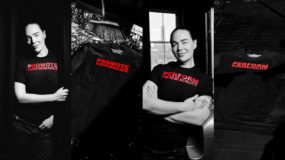Choreographers Simone Forti and Yvonne Rainer’s work made a profound impact on the dance scene starting in the 1960s, and the reverberations continue to this day. This event celebrates their legacy with the publication of Valerie Witte and Sarah Rosenthal’s essay collection One Thing Follows Another: Experiments in Dance, Art, and Life through the Lens of Simone Forti and Yvonne Rainer. The evening will feature readings from the book; a “live choreography” performance by Sally Silvers with dancers Benedict Nguyễn and Jimena Paz; and a panel discussion with the authors, performers, and choreographers Kyle Marshall and Donna Uchizono. Hosted by Performance Space New York and New York Live Arts.
Archives: Shows
Remesas y Sobremesa: Tequio (Mutual Aid) in an Era of Deportation and Borders
Join us for the second iteration of Remesas y Sobremesa, an ongoing series co-presented by PSNY as part of The Clemente Soto Velez Cultural Center’s multiyear Historias initiative. Remesas y Sobremesa invites you to gather around the table, where the warmth of food and shared meals meets thoughtful dialogue. This edition will be focusing on Migration and Spiritual Belief, one of Historias core thematic tracks.
Artist and anthropologist Cynthia Santos-Briones will host an intimate discussion over shared food and drink about mutual aid, her recent border trips to Mexico, and NYC’s migrant services.
Santos-Briones, along with academic Michel Castañeda, journalist Paola Ramos, and photographer Natalia Mendez, will discuss mutual aid as a vital response to anti-immigrant policies and how to provide immediate and long-term relief to fractured communities. The conversation will highlight the role of artists as cultural bridges—preserving and sharing knowledge through their work.
WILLIE NORRIS x PERFORMANCE SPACE NEW YORK

*AVAILABLE IN SMALL–4XL*
Get yours at our Gala Afterparty on Friday March 28, 10pm – 2 am.
Or pre-order here and enjoy the convenience of having it shipped to you in April.
In celebration of our 2025 Spring Gala honoring Yoko Ono, Fran Lebowitz, and Dr. Adrienne Edwards, we worked with Gala Creative Director Willie Norris to create a collaborative special edition t-shirt.
PROMOTE PERFORMANCE is the central motto of this year’s event, a celebration of New York and our community of artists, visionaries, and supporters.
PERFORM HOMOSEXUALITY is the event’s unofficial dress code – meant to spark self-expression, liberation, and celebration!
Performance Space New York Gala 2025
Location
150 First Avenue, 4th Floor inside our Keith Haring Theatre
Concept
NYC: A Space for Everyone
Honoring
Yoko Ono
Fran Lebowitz
Adrienne Edwards
Creative Direction
Willie Norris
Gala Chairs
Slobodan Randjelović & Thomas Rom
Spectacular Finale
Debbie Harry & Kelsey Lu
MCs
Julio Torres & Martine Gutierrez
Voice of God and the MTA
Bernie Wagenblast
Tributes by
Martin Scorcese & Ralph Lemon
Additional Drama
Amari Diosa, Boy Radio, Perla Batalla, Charlene Incarnate & Macy Rodman
Cocktails—6pm
Dinner by Indochine—8pm
Afterparty—10pm
Questions
If you have any inquiries about purchasing a ticket or table please email us.
– Cocktail Party Ticket
– One Bargain Seat!
– 1 ticket
– A private table section for 5 people
– Half a page in the Gala brochure
– A private table section for 8 people
– A page in the Gala brochure
– A special table section at our Gala with premier location (12 people)
– A page in the Gala brochure
– A special table section with premier location (18 people)
– A page in the Gala brochure
Committee
Adrian Danchig-Waring, Agnes Gund, Alexander Ferrando, Amy Rose Silverman, Aminatou Sow, Andrea Rosen, Anicka Yi, Anthony Roth Costanzo, Ben Rodriguez-Cubeñas, Cécile Winckler, David Zwirner, Ethan James Green, Etienne Russo, Gagosian, Gladstone, Hanna Liden, Hauser & Wirth, Hari Nef, Heather Flow, Jeffrey Lee, Jessica Mitrani, Josh Kline, Julie Mehretu, Liutauras Pšibilskis, Lehmann Maupin, Lissy Trullie, Lizzi Bougatsos, Marina Abramović, Maxime Plescia-Büchi, Meaghan Gragg, Mendes Wood, Miles Greenberg, Narciso Rodriguez, Nicole Eisenman, Pace, Princess Marie-Luise von Sachsen, Salon 94, Sarah Arison, Sean Leffers, Sophie Mörner, Ted Oberwager, Whitney Mallett
Screening of Borderland: The Line Within
Cine Farito will host a community gathering and screening at Performance Space New York of Borderland: The Line Within, the latest feature documentary from Oscar, Emmy and Overseas Press Club Award-winning filmmaker Pamela Yates. Borderland explores and exposes the cruel human cost of immigration at the same time as it weaves in stories of immigrants who want to build a social movement to demand their human rights. A conversation with its filmmakers and community gathering will follow.
About Cine Farito
Cine Farito is a group of families partnering with filmmakers to shed light on the issues that deeply affect marginalized communities. Through film screenings, we raise funds to provide direct financial assistance to the most vulnerable families in our community, whose safety is threatened by harmful federal immigration policies and exclusion.
Who the funds will go to:
As an ad-hoc subcommittee of the Family Association of PS513, Cine Farito is committed to advocating for immigrant rights and humanity. The funds raised will support families in our community who are in urgent need of legal or economic resources.
Our initiative begins with screenings of three powerful documentaries—Borderland (dir. Pamela Yates), The Infiltrators (dir. Cristina Ibarra & Alex Rivera), and abUSed: The Postville Raid (dir. Luis Argueta). These films tell gripping, urgent stories of the immigrant experience in today’s climate, raising awareness and amplifying the need for justice. All funds will directly benefit individuals and families in our community facing legal and financial hardships.
